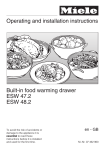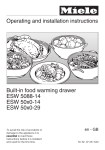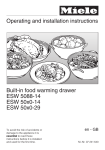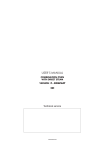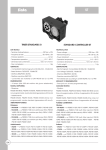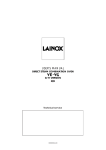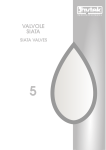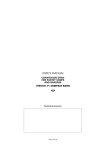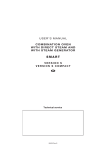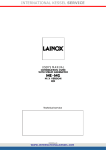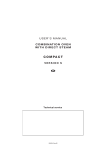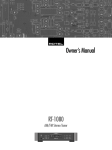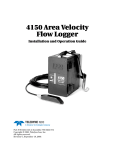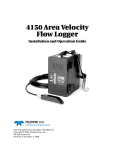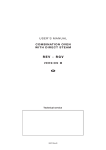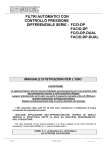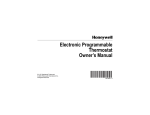Download USER`S MANUAL
Transcript
USER’S MANUAL COMBINATION OVEN WITH AND WITHOUT STEAM GENERATOR VERSION D EN Technical service 90023520rev01 CONTENTS 1 2 3 4 5 6 7 8 9 10 11 12 13 14 • GENERAL REMINDERS • POINTS TO REMEMBER • DESCRIPTION OF KEYS • MANUAL SETTINGS FOR ONE-PHASE COOKING • SETTING THE CORE PROBE • HUMIDITY CONTROL SYSTEM • SPECIAL PROGRAMS 7.1 • HOLDING AT THE END OF COOKING: COOK & HOLD 7.2 • REHEAT PROGRAM 7.3 • PROGRAMS (FACTORY SET) 7.4 • SWITCH ON THE OVEN 7.5 • SELECT THE REHEAT PROGRAM 7.6 • CHANGING THE PROGRAM rP • OPERATING DETAILS • PRACTICAL ADVICE • DAILY CLEANING • ROUTINE MAINTENANCE • DESCALING THE BOILER • MAJOR SERVICING • SELF-DIAGNOSIS AND FAULT IDENTIFICATION PAGE 3 4 5 7 9 11 12 12 12 12 12 13 13 14 15 16 17 17 19 19 VERSIONS D - Manual controls with electronic control, humidifier, manual vent, lighting and core probe (optional). The manufacturer accepts no liability for any inaccuracies in this manual attributable to printing or copying errors. We reserve the right to modify our products as we deem fit, without impairing their basic features. The reproduction or copying of any part of this manual by any means whatsoever is strictly forbidden unless authorized previously in writing by the manufacturer. ALI S.p.A. - 01.09.2004 2 90023520rev01 1 • GENERAL REMINDERS Repairs may become necessary over time; these and all major servicing operations must be performed exclusively by technicians employed by the manufacturer or an authorized service centre. 1.1 1.2 1.3 • There are surfaces of the oven that become hot during operation. Take care! 2003 AC 230 V TYP. NR xxxxxxxxxx 50 Hz Qn 18 kW A3 IT IPX 5 1.9 • Ask the installer for information on correct operation and use of the water softener; incorrect or incomplete maintenance is at the origin of the formation of scale, which would badly damage the oven. B13 Cat. II 2H3+ 1.00 kW kPa 200 - 500 B23 P mbar 20; 28-30/37 0085 • In the event of technical assistance being required, the trouble must be described in as much detail as possible, so that a service technician will be able straight away to understand the nature of the problem. 1.10 • In the event of breakdown or faulty operation, switch off the oven immediately! • Should it become necessary to call out a service technician, all essential identification details of the appliance are shown on the data plate, located at the right-hand side on the bottom. 1.11 • The room, in which the oven is to operate, must be well ventilated! 1.12 • Safety sticker • Maximum height for inserting containers with liquids • Each appliance is equipped with a data plate identifying the model and its main specifications. An example is given below of a dataplate for an electric oven and one for a gas oven. 1600 mm (63 inch) 1.8 - 03 LX TYP. MG 101 "P" • Only suitably trained kitchen personnel should be allowed to use the appliance. 1.5 1.7 IPX 5 • This appliance must only be used as specified in the design, i.e. cooking foods. Any other type of use is improper and therefore dangerous. • The oven must not be left unattended during operation. kPa 200 - 500 8 kW • Carefully read the directions given in this manual; they contain important information on safety during installation, operation and maintenance. Keep this manual in a safe place for future consultation! 1.4 1.6 2003 TYP. ME 061 "P" NR xxxxxxxxxx 50 Hz 3N AC 400 V 3 90023520rev01 2 • POINTS TO REMEMBER 2.1 • Before any food is cooked in a new oven, the interior must be thoroughly cleaned (see “Daily Cleaning”). 2.2 • At the end of the working day, clean the oven thoroughly inside and out; this will ensure smooth operation of the appliance and prolong its useful life. 2.3 • Do not use high pressure water jets when cleaning the oven! 2.4 • For daily cleaning, use only alkali based products suitable for the purpose. Abrasive materials and products should not be used as they will damage the surfaces. 2.5 • Always switch off the appliance when work is finished, and shut off all energy supplies (electricity, water, and gas if connected). 2.6 • Avoid any operation that might cause cooking salt to be deposited on the steel surfaces of the oven; if salt is accidentally spilled, rinse off immediately and thoroughly. 2.7 • After steam cooking, open the door carefully to avoid being hit by the rush of residual steam escaping from the oven. Failure to observe this warning may be dangerous for the operator. 2.8 • To ensure safe operation of the oven do not obstruct the vents or any other opening in the casing! 2.9 • To ensure long term efficiency and reliability of the oven, scheduled servicing should be carried out at least once a year. With this in mind, customers are recommended to sign a service agreement. Failure to observe basic safety guidelines may jeopardize the smooth operation of the oven and expose the operator to serious danger! The manufacturer accepts no liability if the original function of the oven is altered or there is tampering or failure to observe the instructions given in the manuals. 4 90023520rev01 3 • DESCRIPTION OF KEYS ON-OFF (KEY 1) Turns on the control panel, activates selfdiagnosis. Key light on: appliance ready for use. Key light off: appliance powered, control panel off. START-STOP (KEY 16) START-STOP key: to start and stop cooking in progress. • Key light on: START, cooking started. • Key light blinking: TEMPORARY STOP obtained by opening the door or pressing the key once. Cooking and remaining time are stopped. Closing the door or pressing key 16 again restarts cooking. • Key light off: FINAL STOP obtained by keeping key 16 pressed for 3 seconds: cooking stops, as if the time had elapsed. CONVECTION (KEY 2) CONVECTION cooking mode key. STEAM (KEY 3) STEAM cooking mode key. COMBI (KEY 2 + 3) COMBI cooking mode key. 3.1 • OVEN LIGHT KEY (KEY 22) Pressing this key switches on the oven light, permitting the operator to check the progress of the cooking. 3.2 • RAPID COOLING KEY WITH DOOR OPEN (KEY 21) This function is activated only with the oven door open. Pressing the key activates the fan, which rapidly lowers the temperature in the oven to 50 °C. This function is particularly useful if one cooking operation at high temperature is to be followed by another using a much lower temperature, or when the oven needs cleaning immediately after a cooking operation (see “Daily Cleaning”). 3.3 • CAVITY VENT KEY This function is only activated in convection mode; turning the valve 39 extracts excess humidity from the cavity. Vent open Vent closed 5 90023520rev01 3 • DESCRIPTION OF KEYS OPERATIONS 3.5 Note: The appliance is fitted with an automatic system for reducing the cavity temperature in all cooking modes. If the temperature exceeds the display setting by 30 °C, the humidifier automatically directs cold water into the oven and the temperature is rapidly lowered. This precludes the possibility that food could start cooking with too high a temperature in the oven. In addition, the added moisture prevents foods from drying up. • HUMIDITY KEY (KEY 14) This function is useful for foods that require added humidity when cooking. Press the key and hold for as long as it is wished to let moisture into the oven, the corresponding LED will light up for as long as the key is pressed. 6 90023520rev01 4 • MANUAL SETTINGS FOR ONE-PHASE COOKING OPERATIONS 4.1 4.2 4.3 Note: Approximately 10 sec. after releasing the knob, the display will revert to the actual oven temperature. • SWITCH ON Press key 1. If a symbol appears in the fault warning display (display 5-6), refer to “Self-diagnosis and fault identification”. Page 19. 4.4A • SET THE TIME The time display 6 shows [ 000 ]. Turn knob 26: - to the right to set the cooking time; - to the left to set infinite time [ Inf ]. • COOKING MODE SELECTION The two LEDs of the cooking mode keys blink: press the desired cooking mode key (2 - 3 - 2+3). The LED of the selected cooking mode remains permanently alight (while the other one stays off) or, in combi mode, with both lights on steady. Or 4.4B • SET THE CORE PROBE See “Setting the core probe”. The settings are saved approx. 10 seconds after the last setting. • SET THE TEMPERATURE The temperature display shows the temperature of 130 °C. Turn knob 25 to set the temperature (to the right increases, to the left decreases), which will be shown in the display. 7 90023520rev01 4 • MANUAL SETTINGS FOR ONE-PHASE COOKING STARTING THE COOKING PROGRAM OPERATIONS Displaying and changing saved values If, during cooking, it is necessary to check the settings, turn knob 25, 26, the displays will blink. If the values displayed have to be modified, use the relevant knob or keys. After approx. 10 sec. the new data are saved automatically and the displays show the actual values. Place the food in the oven. Refer to the “Practical Advice” heading for more information. Page 15. If the core probe is to be used, refer to “Setting the core probe” and“Hints on using the core probe”. Page 9. 4.5 • START Press key 16 to start cooking: the LED associated with the key remains permanently alight. Note: When switching on the appliance for the first time on any day, the steam generator drains the water contained, it turns on timed steam generator washing, then, after filling with water, it AUTOMATICALLY PREHEATS the steam generator. When starting a program that includes steam or combi cooking cycles, the program is automatically started as soon as the steam generator has reached the preheating temperature so as to avoid starting the program without any steam. The intermittent LED of key 16 indicates that the steam generator has not yet reached the preheating temperature. At this point... the temperature display indicates the actual oven temperature. The time display indicates the time remaining to complete cooking. The luminous dot alongside the value indicates: blinking = cooking in progress; permanently alight = cooking suspended. This occurs, for instance, when opening the door (refer to “Operating Details”). Page 14. 4.6 • END OF COOKING If infinite time has been selected, stop cooking manually by pressing key 16 for a few seconds (LED next to key off). If a cooking time or core probe temperature has been entered, a beep will be generated when the time elapses or the set probe temperature has been reached to indicate that cooking has terminated (LED next to key 16 OFF). Just open the door to stop the beeping. Remove the food from the oven, following the directions given under paragraph 2.7 of the “Points to remember” heading. Page 4. 8 90023520rev01 5 • SETTING THE CORE PROBE in connection 27 in any time operation mode; with the oven on stand by, keeping key 12 pressed for a few seconds, display 6 will show the probe temperature for a few seconds. This permits checking the temperature at the core of the food not being cooked and therefore outside the oven. Foreword The core probe allows cooking to be regulated by monitoring the temperature at the core of the product. This device overrides the time setting, and cooking stops as soon as the temperature at the core of the product reaches the selected value. The core probe can be handily used as a portable thermometer, by inserting the probe OPERATIONS 5.1 • COOKING WITH CORE PROBE Caution: When cooking with the core probe and “ERR SP” is shown on display 6, it is necessary to connect the core probe to connection 27. AUTOMATIC HOLDING FUNCTION If you want to keep the food hot at the end of cooking: set infinite time [ Inf ], then press key 12, and set the required core temperature with knob 26. The dish will keep warm and ventilation will switch on intermittently until you decide to stop the holding function. Once the oven temperature has been set (as described under the relevant headings), press key 12 and turn knob 26 to set the required core temperature. Connect the core probe to connection 27, insert the probe into the food (see “Hints on using the core probe”), and proceed according to the cooking mode selected. Press key 16 to start cooking. PRACTICAL EXAMPLE Setting Mode: Convection Oven temperature: 140 °C Time: Infinite Core temperature: 78 °C What happens Once the temperature at the core of the food reaches 78 °C with the oven temperature at 140 °C, the heat source shuts off and will automatically come into operation again when the core temperature drops by 1 °C. In practice, it is no longer the oven temperature setting that regulates the operation of the heat source, but the temperature selected for the core probe. Caution: Wait for a few seconds after inserting the core probe in connection 27 (the time it takes the electronic card to identify the probe), then start cooking with key 16 START/STOP. 9 90023520rev01 5 • SETTING THE CORE PROBE Optional: On request and without any specific adaptation, it is possible to connect a needle probe to control the temperature of vacuum-packed foods or small items. In cooking with this sensor, the position of the core probe is extremely important. The probe must be positioned from the top downwards at the centre of the food to cook and be fully inserted. In pieces whose thickness is less than twice the probe, it is inserted horizontally to the tabletop so that the tip of the probe is anyhow in the middle of the food (see figure). It is also recommended to insert the probe with the food at the centre of the oven. NO YES NO YES Advantages • improves control over the cooking process, eliminating the risk of loss and waste; • permits accurate cooking irrespective of the quality or size of the product; • saves time because cooking control is automatic; • guarantees hygiene; with precision monitoring of the core temperature, there is no need for food to be handled, poked or prodded; • ideal for large items of food; • cooking precision to one degree centigrade for delicate foods such as: ROAST-BEEF; • HACCP requirements always respected. 10 90023520rev01 6 • HUMIDITY CONTROL SYSTEM This system permits obtaining the same cooking result for the same food cooked in different quantities. Foreword The humidity control system makes it possible to keep a constant level of humidity in the cavity when cooking by convection or with the combi cycle. Especially advantageous for fresh products that cannot have the same moisture content from one day to another, but which when cooked will always have the same aspect and consistency. OPERATIONS 6.1 Advice Defining the humidity value requires a certain amount of practical experience. Nonetheless, it is impossible to commit a catastrophic error, and this function undoubtedly enhances the appearance of the food. • COOKING WITH THE HUMIDITY CONTROL SYSTEM Note: The cooking mode must be Convection or Combi Once the cavity or core probe temperature has been set (as described under the relevant headings), press key 14 to set the desired value, from H00 (very dry) to H99 (very humid). Place the food in the oven and, if the core probe is being used, insert the probe (see “Hints on using the core probe”), connect the core probe to connection 27 and proceed according to the cooking mode selected. Therefore, if you have chosen... Ideal for: Foods that tend to dry up, small items or foods that release excess humidity (e.g. roast chicken) and when reheating especially on a plate. Advantages Repeatable results, even when foods are cooked together with others having different characteristics. 11 90023520rev01 7 • SPECIAL PROGRAMS terms of presentation, degree of cooking, reduction in weight loss, tenderness of the food to serve. Foreword Their purpose is to complete a cooking process to obtain the best results, without the operator taking any direct action, in OPERATIONS 7.1 7.2 7.3 • HOLDING AT THE END OF COOKING: COOK & HOLD This function makes it possible to keep food warm when cooking has just ended, enabling the operator to serve the food “warm at just the right time”. The succulence of the food remains undiminished, the holding precision is to one degree Celsius, consuming very little power... The best HOLDING results are achieved when there is temperature control with the core probe. • FACTORY-SET PROGRAMS Version D is equipped with factory-set programs. The aim is to help the chef use the oven immediately. r1 = REGENERATION on plate with core probe r2 = REGENERATION on pan with core probe rP = user-definable program regeneration See table attached below. • REHEAT PROGRAM Foreword Reheating plays a significant role in an organized system of kitchen management: cooking cooling conserving reheating serving. Foods can be reheated either in a pan or on a plate. 7.4 • SWITCH ON THE OVEN Press key 1. A short beep indicates that the self-diagnosis routine has been completed. If a symbol appears in the fault warning display, refer to “Self-diagnosis and fault identification”. Program r1: RIGENERATION 1 (On plate) Cooking mode Temperature °C Core probe °C Time h : m Cycle 1 Convection Cycle 2 Combi Fan speed Automatic humidity Vent 140 - Infinite - - - 115 65 8' Normal 20% Off Core probe °C Time h : m Fan speed Automatic humidity Vent Program r2: RIGENERATION 2 (On pan) Cooking mode Temperature °C Cycle 1 Convection 140 - Infinite - - - Cycle 2 Combi 130 65 15' Normal 30% Off 12 90023520rev01 7 • SPECIAL PROGRAMS OPERATIONS 7.5 • SELECT THE REHEAT PROGRAM Advice Reheating is intended as a process of warming previously cooked foods to a serving temperature of up to 65 °C at the core. This must take place as quickly as possible, clearly observing the local health and hygiene regulations. For deep-frozen and/or frozen products, the oven temperature is set to 160 °C, the food is put into the oven and after a few minutes, when it becomes possible, you pass on to use the core probe; clearly, the program needs to be temporarily modified. Note: Programs r1 and r2 are already stored in memory. Press key 50, the LED will blink. To select the r1, r2 or rP program, turn knob 26. To confirm the program, press key 50. 7.6 • CHANGING PROGRAM rP Press key 50 to go to the setting. Turn knob 26 to display rP; confirm by pressing key 50. Select the reheat mode. Set the oven temperature. Set the time, which generally will be infinite, by turning the relative knob, or the core probe temperature by pressing key 12. It is advisable to use the needle probe for particularly thin or small items. At this point we recommend you set the humidity control function (see under the relevant heading) or open the vent. After approximately 10 seconds (T I M E -O U T ) the new data are saved automatically and the displays show the actual values. Advantages This system makes it possible to present the food “freshly cooked”, as regards its appearance, flavour and firmness, even after a few days' conservation at +3 °C. The appliance is versatile as it can perform differentiated functions without the aid of additional equipment. 13 90023520rev01 8 • OPERATING DETAILS status). It is anyhow possible to check the settings. For this purpose, proceed as follows: FOREWORD During cooking (LED on steady) the displays show the actual values (current OPERATIONS 8.1 • DISPLAYING SETTINGS DURING COOKING PHASE (without stopping) Turn knob 25 or 26, the displays blink showing the previous settings. After 10 sec. the actual values reappear (TIME OUT), so in general: display blinking: value set. display on steady: actual value. 8.2 • CHANGING THE SETTINGS DURING THE COOKING PHASE (WITHOUT STOPPING) 8.2 a • TEMPERATURE AND TIME To change the setting, turn the relevant knob to set the new value (increasing to the right decreasing to the left). The displays show the settings that have just been made, after 10 sec. the actual values reappear. 8.2 b • COOKING MODE Press the key corresponding to the new cooking mode. The corresponding LED will light up. 8.2 c • HUMIDITY CONTROL Press the humidity control function key 14 (the display will show [ H.. ], set previously). Turn knob 26 to make the new setting. After 10 sec. the actual values reappear. 8.3 • TEMPORARY STOP Open the door or press key 16: the corresponding LED blinks. Cooking stops and the timer pauses until such time as the door has been closed or key 16 pressed a second time. Cooking will resume automatically from the point at which the interruption occurred. 8.4 14 90023520rev01 8.2 d • CORE PROBE Press the core probe key 12, display 6 will show the core probe setting. Turn knob 26 to make the new setting. After the 10 seconds of TIME OUT the actual values reappear. • FINAL STOP To stop or permanently interrupt a cooking program for which infinite time is set, press key 16 and hold for approx. 3 seconds. A continuous beep confirms the end of the cooking operation as if the full time had elapsed, and the LED associated with key 16 goes out. 9 • PRACTICAL ADVICE 9.1 9.2 • PREHEATING THE OVEN The oven preheating cycle is extremely important and useful for successful cooking. As a general rule, always preheat the cavity when empty, setting the temperature between approximately 15% and 25% of that to be utilized subsequently in cooking. In the case of steam cooking, preheat the empty cavity using convection mode as this will allow temperatures of over 130 °C to be selected. • COOKING LOADS The depth of the pan must be suitable for the height of the food. For even cooking, it is preferable to distribute the load over several shallow pans rather than loading just one extremely deep pan. Keep to the weights specified in the following table. Nr. pans Maximum load per pan Maximum oven load 6 x GN 1/1 4 kg 24 kg 7 x GN 2/1 8 kg 56 kg 10 x GN 1/1 4 kg 40 kg 10 x GN 2/1 8 kg 80 kg 20 x GN 1/1 4 kg 80 kg 20 x GN 2/1 8 kg 160 kg 40 x GN 1/1 4 kg 160 kg 9.3 • FROZEN/DEEP-FROZEN PRODUCTS The oven must be preheated and loaded respecting the quality and nature of these foods. For example, frozen spinach must not be hit with temperatures that are too high as, due to its nature, it could dry out on the outside and impair the result. 9.4 • TYPES OF CONTAINER For optimum results, it is indispensable to use the right pan for the different kinds of food: aluminium or aluminium plate pans for confectionery and baked foods, perforated pans for steam cooking, mesh pans for pre-fried foods such as potatoes. 9.5 • CLEARANCE BETWEEN CONTAINERS When loading the oven with the food to cook, it is recommended to pay special attention so that there is sufficient clearance between containers. This makes it possible for the heat and air to distribute evenly for a more uniform result, which would not be possible if the food in one pan were in contact with the pan above. 9.6 • LESS SEASONING By using this type of oven it is possible to virtually eliminate the use of seasoning, oil, butter, fat and flavouring. With a minimum use of such ingredients in cooking, the natural flavours of the food are highlighted and the nutritional content remains intact; this brings the benefits of a more dietconscious type of cuisine. Notes: Obviously, when loading the oven you should take account not only of the weight of the food, but also its size, consistency and thickness. CAUTION Do not insert pans/containers with liquids deeper than 1.6 m, see 1.12. 15 90023520rev01 10 • DAILY CLEANING 10.1 • THOROUGH CLEANING... ... is a prerequisite for faultless cooking and better yields: • the food's own flavour remains unchanged; • during operation there are no fumes caused by previous remains of food that burn; • energy savings; • less maintenance work and a longer service life; • the simplicity of the procedure means that a thorough clean can be carried out quickly and with minimum inconvenience to the operator: Activate automatic cooling with key 21 if the oven is very hot. Turn on the “CL” oven cleaning cycle to remove day-to-day dirt. Switch off the oven with key 1. Press key 50, display 6 blinks “rP”. Turn knob 26 to the right to show “CL”. Press key 50 and then 16 to turn on the MANUAL wash program explained below. Cycle 1 - Cooling/preheating: the display shows “RAF” if the oven temperature is high, “ATT” if the oven temperature is low, on reaching the temperature it shows “DET IN”, the light of key 16 blinks to indicate a TEMPORARY STOP, a beep signals it is time to open the door and spray detergent in the oven. Close the door and press key 16 to turn the wash cycle back on, after which the operator needs to take no other action until the end of the program. The end of the program is defined by a cyclic beep, open the door to turn it off. Switch off the appliance with key 1. It is a good rule at the end of the washing cycle to rinse the inside of the oven again with the shower (optional), wipe the front seal of the oven with a sponge or cloth to protect it from early deterioration. 10.2 • CAUTION Never use direct or high-pressure jets of water to clean the outside of the oven. Never use corrosive and/or abrasive substances on steel surfaces, and avoid scouring or scrubbing with steel wool or wire brushes, as irreparable damage could occur. Similarly, aggressive detergents, of nonalkaline formulation containing high percentages of sodium and ammonia, can soon damage the seals, jeopardizing oven efficiency and operation. The outside of the oven should be washed with a sponge and warm water with an ordinary detergent suited to the purpose. 10.3 • It is recommended to use a specially formulated detergent. CUBECLEAN Alkaline detergent in a tank CUBECLEAN Cycle 2 - Cleansing action 10 lt. Cycle 3 - Steam cycle DL 010 If consistent remains of dirt deposit on the outlet filter in the middle of the bottom of the oven, clean so as to ensure a free flow of water and detergent. 16 90023520rev01 11 • ROUTINE MAINTENANCE 11.1 • PERIODICALLY... ... It is recommended to clean the deflector and pan racks as necessary. For this purpose, proceed as follows: • stop and shut off all utilities (electricity, water, and gas if connected); • take out the pan racks; • using a screwdriver of the right size, or a coin, unscrew the deflector screws to be able to clean the back; it is recommended to use the hand-held shower (optional) for thorough rinsing; • dry with a clean cloth; • it is necessary to remove the deflector if the dirt is particularly tough to remove; do not use abrasives or scourers that would damage the steel surface; size permitting, wash the deflector in a dishwasher. Secure the deflector in the oven, making sure the two fixing screws on the righthand side are well tightened. 11.2 • PROLONGED IDLE PERIODS If the oven is to stand idle for any length of time (e.g. holidays or seasonal closing) it must be cleaned thoroughly, leaving no traces of food or dirt. Leave the door slightly ajar so that air can circulate inside the oven. Be absolutely certain to shut off all utilities (electrical power supply, water, and gas if connected). For added care after cleaning, the external surfaces can be protected by applying a proprietary metal polish. 12 • DESCALING THE BOILER The appliance is able to count the hours of operation of the steam generator and then to warn the operator with the “CAL” message when it is necessary to activate steam generator descaling with the special “de” cycle. The “CAL” message does not stop the appliance for obvious reasons of service, it is anyhow recommended to activate the "de" program in the hours nearest to the message appearing. To check the total remaining hours to the “CAL” message appearing, switch off the oven with key 1, keep key 3 pressed for 5 seconds, the display will show the remaining hours. The presence of scale causes loss of power in the steam circuit and serious damage to the steam generator. Note that the steam generator runs a drain and wash cycle automatically every day so as to regenerate the water in it. Descaling frequency is defined by several parameters entered on the electronic card by the technician at the time of installation on the basis of the characteristics of the supply water (upstream from the softener) and on the basis of its technical characteristics. The “CAL” message appears when the appliance is switched off. The end of the “de” descaling cycle permits resetting the total number of hours and the removal of the message: to permit this operation, disconnect the oven from the electric mains for a few seconds after the end of the descaling program. Descaling should be performed with the appliance cold and clean (see “Daily Cleaning”), preferably with the assistance of the authorized technician. 17 90023520rev01 12 • DESCALING THE BOILER Activating the “de” descaling cycle Switch on the oven with key 1, press key 50 and turn knob 26 until the display shows the “de” program, press key 50 to confirm the program. The display shows “ATT” wait, the automatic operations of boiler draining and washing are activated, then “det” “IN” appears with a cyclical audible warning telling the operator to add the descaling agent after unscrewing the cap A (the dilution per litre, if necessary, should be done following the directions of the manufacturer of the product), observing the capacity of the boiler, see table: GAS ELECTRIC Models Litres Litres 6 x GN 1/1 2.5 3.5 7 x GN 1/1 2.5 3.5 7 x GN 2/1 - 11 10 x GN 1/1 4 11 10 x GN 2/1 6 12.5 20 x GN 1/1 6 18 20 x GN 2/1 20.5 30 12.1 • DESCALING ACTION Press key 16; the boiler fills to capacity with water mixed with descaling detergent. “CYCLE 2”: This is the second automatic cycle that permits operating the oven with steam for 25 min. so as to thoroughly cleanse the steam generator and the pipes for introducing steam into the oven. The cycle is completed with the phases of: drain boiler, wash boiler by introducing ordinary mains water and filling with cleaned water. A 5 “CYCLE 1”: This is the first automatic cycle permitting the boiler to heat up and hold its temperature for 30 minutes (countdown on display 6) so the descaling agent can act effectively, after which time the boiler drains off the content (impurity of detergent mixed with water). Check that it flows out freely, if it does not then call in the technical assistance service as the drain could be blocked and the boiler need servicing. This problem is also indicated on displays 5-6 (see “Self-diagnosis and fault identification”). Afterwards the boiler is cleaned of the more resistant particles of scale by forcing in normal tap water, then it loads cleaned water. • Close the cap “A”. 18 90023520rev01 12 • DESCALING THE BOILER Caution: This operation must be carried out under the close supervision of the operator! The operator must adhere strictly to the precautions (mask, gloves etc.) for use of the product! The descaling cycle must not be interrupted for any reason! Interrupting the cycle renders the whole process ineffective, wastes descaler, and provokes the risk of contamination if the descaler has not been completely flushed out of the boiler. An interruption will also prevent the electronic control from resetting the boiler hour-counter to zero. Important: The above sequence ensures thorough cleaning of the steam generator that is ready for use, any faults found during the cycle will be signalled on display 5 and 6, at which stage the appliance must NOT be used until an authorized technician has seen it! The correct conclusion of the program is signalled by the “END” message, press key 1 to exit the “de” program, at the same time the number of hours remaining to the next descaling is updated. It is advisable to thoroughly rinse the cavity with the shower at the end of the program. 13 • MAJOR SERVICING 13.2 • With this in mind, customers are recommended to sign a service agreement. 13.1 • To ensure correct and safe operation, the oven must be inspected and serviced at least once a year by a manufacturer technician or authorized service agent. 14 • SELF-DIAGNOSIS AND FAULT IDENTIFICATION 14.2 • If any irregularities are discovered, on the other hand, these are indicated in the displays 5-6. Error codes are extremely important when trouble cannot be remedied by the operator, since they give the service technician an indication a





























